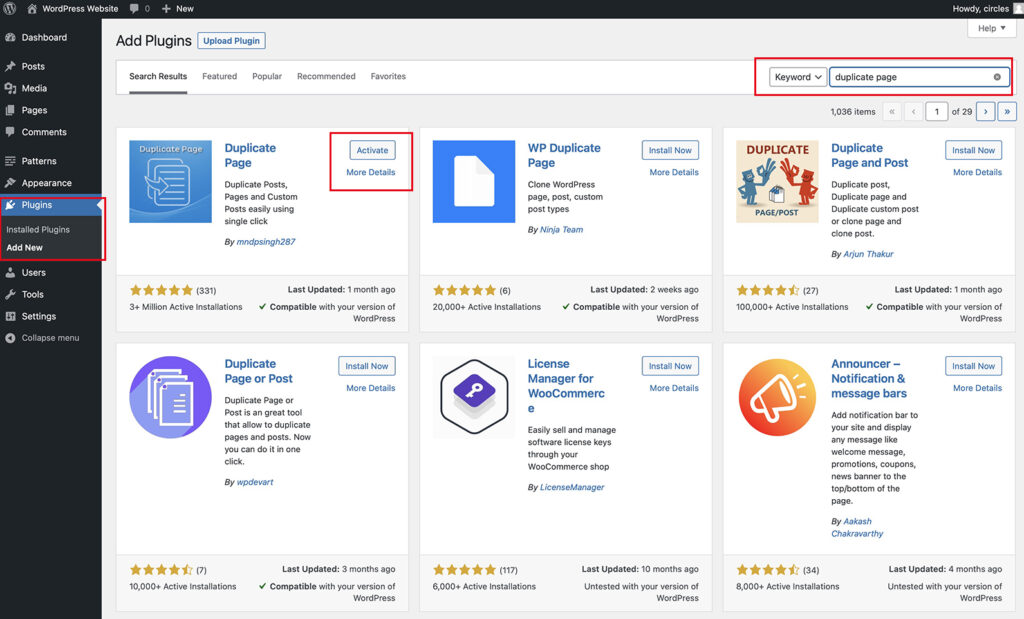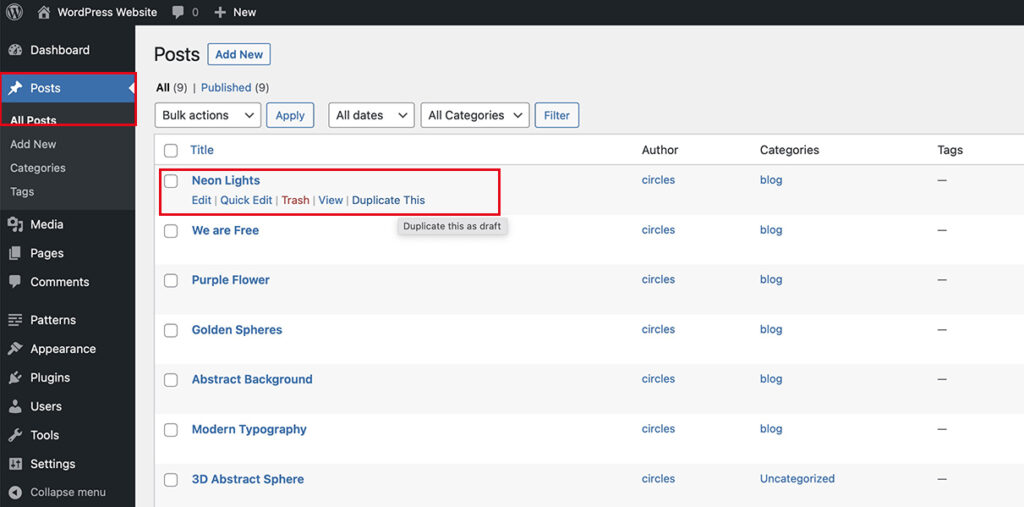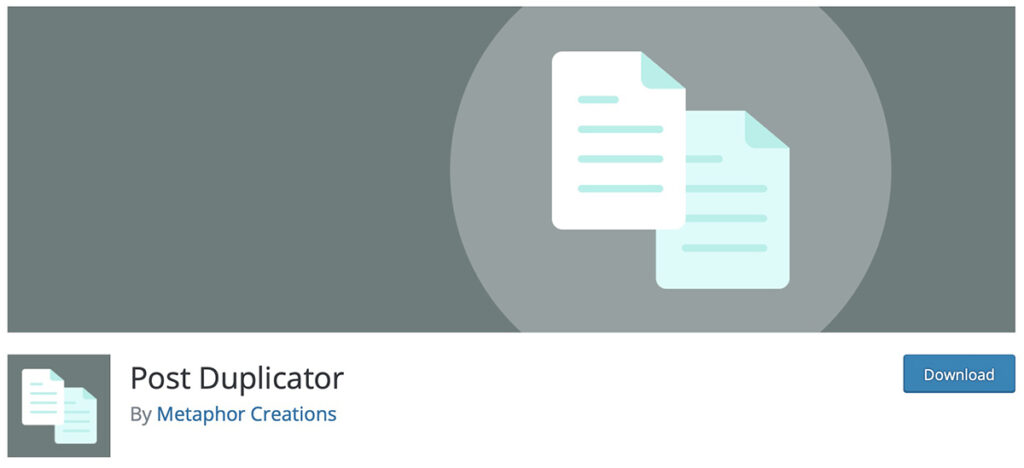Updated: Jun 15, 2023 By: Dessign Team

How to Duplicate a Page or Post in WordPress
Duplicate your WordPress Pages and Posts effortlessly with this guide. Learn how to make exact copies of your website content using a few simple steps. Follow these instructions to achieve duplication in no time.
- Login to your WordPress account
- Open the WordPress Dashboard
- Navigate to Pages or Posts tab
- Click on All Pages or All Posts
- Choose the item you want to duplicate
- Click on the Duplicate button
With these easy steps, you can create identical copies of your Pages and Posts, saving you time and effort. Take advantage of this feature and manage your website content efficiently.
One thing to note, duplication may affect your SEO ranking. It’s advisable to adjust post/page titles, permalinks and content to avoid any potential keyword cannibalization and duplicate content penalties.
Now that you have mastered How to Duplicate a Page or Post in WordPress, utilize this feature to split a long Post or Page into multiple identical items, or create a template for your site’s content.
Cloning a Page in WordPress with Plugins
As a WordPress user, I’ve often found myself needing to duplicate a page or post to use as a template for future content. Thankfully, cloning content in WordPress is a straightforward process, thanks to an array of efficient plugins. In this section, we’ll explore the different plugins available for cloning pages and posts on WordPress, including:
- Duplicate Page
- Duplicate Page and Post
- Post Duplicator
Each plugin comes with its own unique approach, so we’ll dive into how to utilize each plugin to effectively clone your content.
Duplicate Page

One functionality of WordPress is to make a duplicate post without creating it from scratch, which is called ‘duplicate page.’ It allows duplicating posts from pages, custom posts, or even blogs with ease.
Cloning a page in WordPress can be done with the help of different plugins that are available for free such as Duplicate Post, Duplicate Page and Post, Duplicate Page, and Post Duplicator. The cloning method serves well in the case when you need to copy some crucial information on the website.
Step 1.
Inside your WordPress dashboard goto Plugins–Add New–Search for: Duplicate Page plugin–click Install Now and Activate

Step 2:
Goto Your Posts or Pages: For this example I picked Posts: All Posts —Hover over any post you like to duplicate: and it will show you “Duplicate This” click on it and it will duplicate that post as a draft.

Step 3:
Now you see that your post is duplicated as draft and you can go and edit it anyway you like it..

The true history about the heading ‘Duplicate Post’ is that previously users had to use HTML or manually copy-paste their pages or posts for duplication purposes. With the introduction of WordPress plugins like Duplicate Post, it became more convenient and saved time for numerous users.
Duplicate Page and Post

Cloning or duplicating a page or post in WordPress can be done easily with the help of plugins. One such plugin is Duplicate Page and Post that allows users to duplicate both pages and posts with the click of a button.
Once installed, this plugin adds a “Duplicate” option under each page and post on the WordPress dashboard. Clicking on this option will create an exact replica of the original page or post without affecting the original content. This is extremely useful for those who want to create new pages or posts based on existing content.
Another great plugin for duplicating pages and posts is Duplicate Post. This plugin allows users to clone any type of content, including custom post types, with a single click. It also provides options to copy metadata, taxonomies, and attachments.
For those who prefer not to use plugins, cloning pages and posts can be done by enabling cloning via funtions.php code. Once enabled, users can go to their list of pages or posts, hover over the one they want to duplicate and click “Clone”from the drop-down menu.
Post Duplicator

Here is a 5-step guide on how to use Post Duplicator:
- Install the Post Duplicator plugin from the WordPress repository.
- Activate the plugin by going to the Plugins section and clicking “Activate” under the Post Duplicator plugin.
- Once activated, go to the “All Posts” or “All Pages” section and hover over the post or page you want to duplicate.
- Click “Duplicate”, which will create an exact copy of your post or page with a new title appended with “(Copy)” at the end.
- Edit your duplicated post or page as necessary and click “Publish” when finished.
It is worth noting that using the Post Duplicator plugin can save you time if you need to create recurring posts with similar designs such as seasonal sales.
To avoid missing out on maximizing productivity for your website, consider installing this must-have tool that is Post Duplicator.
Duplicate pages in WordPress without plugins? You don’t need no stinkin’ plugins!
Duplicating a Page in WordPress Without a Plugin
As a WordPress user, I know how time-consuming it can be to create a new page or post from scratch, especially when you need to duplicate an existing one. Luckily, there’s a way to easily duplicate a page in WordPress without a plugin!
One way is to enable cloning via functions.php code, which can be added to your WordPress theme. This sub-section will show you how to do that and save you time and energy without having to rely on any plugins.
Enable Cloning via *funtions.php* Code
To enable cloning via functions.php code, follow these steps:
- Open your WordPress Admin Panel
- Then, navigate to Appearance > Theme Editor
- On the right side of the screen under theme files, find functions.php and click on it.
- Scroll down to the bottom of this file and add the following code:
define( 'DISALLOW_FILE_EDIT', true );.
This will prevent anybody from editing theme files directly and make sure that you create a backup first before making changes as making wrong changes may cause undesired results.
Once you have added this to your functions.php file, save your changes.
function duplicate_post($post_id)
// Get the original post
$post = get_post($post_id);
// Create a new post with the same content
$new_post = array(
'post_title' => $post->post_title,
'post_content' => $post->post_content,
'post_status' => 'draft', // You can set the status as per your requirement
'post_type' => $post->post_type
);
// Insert the new post into the database
$new_post_id = wp_insert_post($new_post);
// Duplicate post metadata
$post_meta_infos = $wpdb->get_results("SELECT meta_key, meta_value FROM $wpdb->postmeta WHERE post_id=$post_id");
if (!empty($post_meta_infos))
foreach ($post_meta_infos as $meta_info)
$meta_key = $meta_info->meta_key;
$meta_value = $meta_info->meta_value;
// Exclude some post meta if needed
$excluded_meta = array('_edit_lock', '_edit_last');
if (in_array($meta_key, $excluded_meta))
continue;
// Copy post meta to the new post
update_post_meta($new_post_id, $meta_key, $meta_value);
// Optionally, you can redirect to the newly created post
wp_redirect(get_edit_post_link($new_post_id, ''));
exit;add_action(‘admin_action_duplicate_post’, ‘duplicate_post’);
function duplicate_post_link($actions, $post)
// Add “Duplicate” link to post row actions
if (current_user_can(‘edit_posts’))
$actions[‘duplicate’] = ‘Duplicate’;
return $actions;
add_filter(‘post_row_actions’, ‘duplicate_post_link’, 10, 2);
To enable cloning via functions.php code, it is important to note that adding code in this section of your site requires at least an intermediate skill level. To ensure seamless functionality without harming your website’s structure, be aware of how each bit of information works together.
We recommend testing for mishaps in another environment (such as by creating a local instance of our site) before introducing it to live environments.
Key Takeaway:
- Duplicating a page or post in WordPress allows you to save time by creating multiple copies of the same content without starting from scratch.
- There are several plugins available to clone pages in WordPress, including Duplicate Post, Duplicate Page and Post, Duplicate Page, and Post Duplicator. These plugins have simple interfaces and can be easily installed and accessed from the WordPress dashboard.
- If you prefer not to use a plugin, you can also enable cloning via functions.php code. This method requires a bit of technical knowledge, but it can be a good option for those who want to avoid installing additional plugins on their site.
Conclusion
As the discussion comes to an end, the process to duplicate a post or page on WordPress is relatively simple.
By using the built-in feature, users can easily create an exact copy of their content, including its title, text, and media. This significant feature can save a significant amount of time and effort for individuals who frequently need to duplicate content.
In addition to the duplication process, users can also modify the copied content’s title, URL slug, and content. Moreover, the duplicated content’s unique identifier is different from its parent page, making it independent and separate.
To improve users’ experience, it is crucial to use descriptive titles for content, enabling content to be easily searchable. Users can also install plugins to enhance the duplication feature and customize the duplicated content according to their requirements. By following these simple suggestions, users can effectively utilize WordPress’s duplication feature for their content.
FAQs about How To Duplicate A Page Or Post In WordPress
How can I duplicate a page or post in WordPress?
Duplicating a page or post in WordPress can save you time when redesigning your website or updating your content. You can duplicate everything from the content of the page or post to the associated comments, page template, SEO data, and images. There are two ways to duplicate a page or post: using a WordPress plugin or manually copying and pasting the relevant code or editing the *funtions.php* file.
Why should I use a plugin to duplicate a page or post instead of doing it manually?
Using a plugin to duplicate a page or post is the safest way to do it, since you won’t be modifying your site’s code directly. Moreover, it is quicker, easier, and more convenient. There are many plugins available to do this, such as Duplicate Post, Duplicate Page and Post, Duplicate Page, and Post Duplicator.
Which plugin is the best for duplicating a page or post in WordPress?
There is no universal answer to this question as it depends on your preferences and needs. However, four of the most popular plugins to duplicate a page or post in WordPress are Duplicate Post, Duplicate Page and Post, Duplicate Page, and Post Duplicator. Each of these plugins has its pros and cons, so you should try them out and see which one works best for you.
Can I duplicate multiple pages or posts at once?
Yes, you can duplicate multiple pages or posts at once using Bulk Actions in WordPress. All you need to do is select the pages or posts you want to clone and click on the Clone or Duplicate option.
How can I duplicate a page or post in WordPress without a plugin?
You can duplicate a page or post in WordPress manually by either editing the *funtions.php* file or copying and pasting the relevant code. However, this requires some coding skills and knowledge. If you’re not comfortable editing code, it’s better to use a plugin.
What precautions should I take before editing the *funtions.php* file to enable cloning?
Before editing the *funtions.php* file to enable cloning, you need to be cautious and make a backup of your website first. This ensures that you can revert back to the previous version of your site in case something goes wrong. Moreover, you should use Secure File Transfer Protocol (FTP) or another secure method to edit the file.